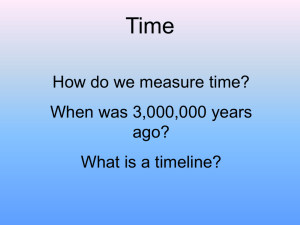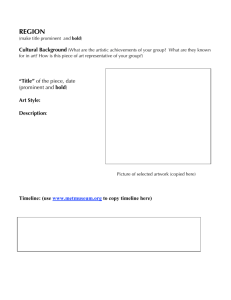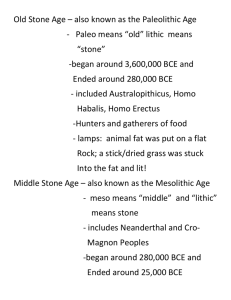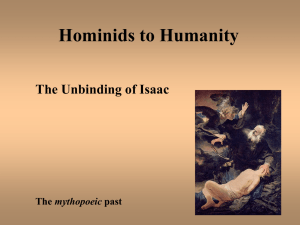The Beginning
advertisement
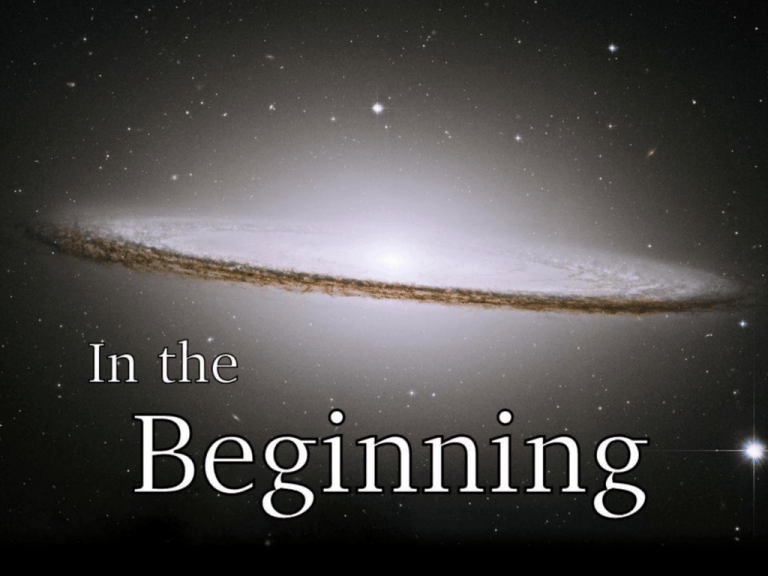
• • • • Australopithecus Homo habilis Homo erectus Homo sapiens 3.9-3 million years ago 2.4 million years ago 1.8 million years ago 280,000 years ago • Evolution – a fact not a theory – “change over time” • Natural selection • Artificial selection • Mutation Biblical Criticism • Form criticism is an analysis of literary documents, particularly the Bible, to discover earlier oral traditions (stories, legends, myths, etc.) upon which they were based. • Tradition criticism is an analysis of the Bible, concentrating on how religious traditions have grown and changed over the time span during which the text was written. • Higher criticism is "the study of the sources and literary methods employed by the biblical authors." • Lower criticism is "the discipline and study of the actual wording" of the Bible; a quest for textual purity and understanding. How old is Earth? • Bishop James Usher (1581 – 1656) Creation “fell upon the entrance of the night preceding, Sunday, October 23,” 4004 BC. • Modern science: 4.5 billion years. Ocean fossils in the Canadian Rockies • By the late 19th century most main-stream Protestant dominations accepted the general concept of evolution. • Catholics have never believed in “absolute truth” of the Bible. • Whether there is a guiding force, an external intelligence, behind this change is up to you. • • • • Australopithecus Homo habilis Homo erectus Homo sapiens 3.9-3 million years ago 2.4 million years ago 1.8 million years ago 280,000 years ago Band Tribe Chiefdom State Total Numbers less than 100 up to a few thousand 5000-20,000 generally 20,000+ Social Organization egalitarian, informal leadership Economic Organization segmentary--poss. made kinship based ranking, up of several "bands", hereditary leaders, leaders lack economic leaders control some or control all aspects of trade class based hierarchy central accumulation and centralized bureaucracy, redistribution, prestige tribute, taxation, laws goods, craft specialization mobile hunter gatherers settled farmers, pastoralists, herders Settlement Pattern temporary camps permanent villages, no one settlement dominates others fortified centers, ritual centers urban cities, towns, frontier defenses, roads Religious Organization shamans religious elders, calendarical rituals hereditary chief with religious duties priestly class, pantheistic or monotheistic religion Architecture temporary shelters permanent huts, burial mounds, shrines large scale monuments palaces, temples and other public buildings Recent or Contemporary Examples Australian Aborigines New Guinea highlanders 18th century Polynesian chiefdoms modern states How do we explain the world around us? • • • • • Myth Magic Religion Philosophy Science • Art • Music • Poetry Venus Figurines 35,000 – 11,000 BCE • • • • emblems of security and success fertility icons porn representations of a mother goddess or various local goddesses. Band Tribe Chiefdom State Total Numbers less than 100 up to a few thousand 5000-20,000 generally 20,000+ Social Organization egalitarian, informal leadership Economic Organization segmentary--poss. made kinship based ranking, up of several "bands", hereditary leaders, leaders lack economic leaders control some or control all aspects of trade class based hierarchy central accumulation and centralized bureaucracy, redistribution, prestige tribute, taxation, laws goods, craft specialization mobile hunter gatherers settled farmers, pastoralists, herders Settlement Pattern temporary camps permanent villages, no one settlement dominates others fortified centers, ritual centers urban cities, towns, frontier defenses, roads Religious Organization shamans religious elders, calendarical rituals hereditary chief with religious duties priestly class, pantheistic or monotheistic religion Architecture temporary shelters permanent huts, burial mounds, shrines large scale monuments palaces, temples and other public buildings Recent or Contemporary Examples Australian Aborigines New Guinea highlanders 18th century Polynesian chiefdoms modern states 10,000 BCE Paleolithic - - - - - - - - - - - - - - - - - - - - - - - - - Neolithic Domesticated Animals Dog Sheep Pig Goat 30,000 - 15,000 BC 11,000 BC - 9000 BC 9000 BC 8000 BC Cattle Domesticated Cat 8000 BC 7500 BC Chicken Donkey Duck Horse Dromedary Camel Goose Yak Bactrian Camel 6000 BC 5000 BC 4000 BC 4000 BC 4000 BC 3000 BC 2500 BC 2500 BC Eurasia Southwest Asia Near East, China Iran Europe, Asia and North Africa Near East India and Southeast Asia Egypt China Eurasian Steppes Arabia Egypt Tibet Central Asia Domesticated Animals -- The Americas Dog 30,000 - 15,000 BC Eurasia Guinea pig 5000 BC Peru Llama & Alpaca 2400 BC Turkey 180 AD Peru Mexico, United States Domesticated Plants • Bottle gourd • Cereal grains – Evidence of flour – Chemical evidence for beer 10,000 BCE 9,000 BCE 10,000 BCE 3,500 BCE Creation and Flood Myths MYTH “. . . A traditional story of unknown authorship, ostensibly with a historical basis, but serving usually to explain some phenomenon of nature, the origin of man, or the customs, institutions, religious rites, etc. of people: myths usually involve the exploits of gods and heroes.” Genesis Traditional Stories “Jahwist” Greek and Mesopotamian Sources “Priestly Source” Final form by c. 538 BCE Biblical manuscripts • Septuagint (Greek) c. 300 BCE • Dead Sea Scrolls c. 150 BCE – 70 CE • Masoretic Text Written c. 100 CE Oldest text c. 1,000 CE Gilgamesh • Sumerian versions from 2150 BCE • Best preserved version (in Akkadian) dates from 1300 – 1000 BCE 1750-1180 BCE 2300-2150 BCE Egypt 2686 - 332 BCE Judah/Israel 830 BCE – 135 CE 1750-559 BCE 5000-2000 BC The Ice Age • Ends c. 12,000 BCE Black Sea Flood c. 5600 BCE 100 meter sea level rise above current sea level. Summary • Transition from Paleolithic to Neolithic. – Younger Dryas • Low-lying areas flood around the world. • Slow development of sedentary cultures.



